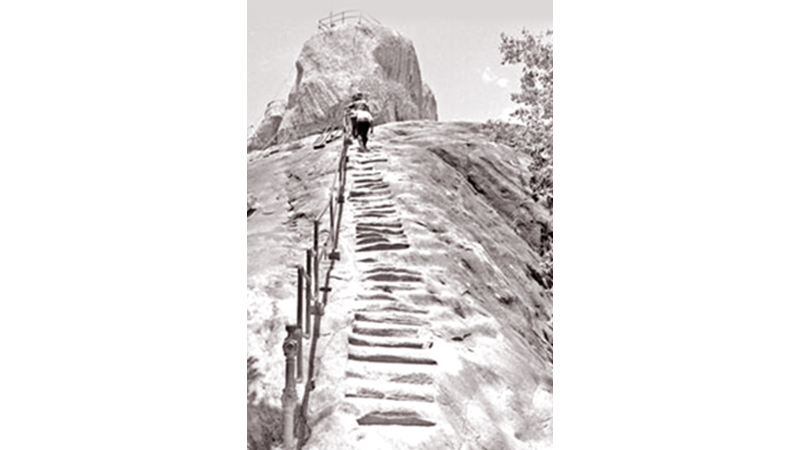Thanks to the royal patronage of Emperor Asoka who decided to send missions abroad at the conclusion of the third Buddhist council at Pataliputra headed by Moggaliputtatissa Thera to propagate Dhamma.
According to ancient chronicles, special importance was attached to the one sent here. It was in the form of a precious gift from the Emperor to his royal and loyal friend King Devanampiyatissa that Dhammadutha mission was sent to Sri Lanka.
Thera Mahinda accompanied by the bhikkhus Itthiya, Uttiya, Sambala, Baddasala, Samanera Sumana and Upasaka Bhanduka arrived from Vedisagiri, alighted on the Missaka (mountain) Pawwa on Poson Full Moon Day, the present Mihintale.
It so happened that King Devanampiyatissa, the ruling monarch, was on a hunting spree with his retinue during the festive season, chasing after a deer when Thera Mahinda called him Tissa.
The astonished King looked around and saw Ven. Arhath Mahinda Thera who said, “O great King, we are disciples of the King of Truth, from compassion towards thee we come from Jambudweepa.” The alarmed King looked up amazingly. A saintly figure in saffron robes, a shaven head, a serene look on his face, summed up the entire visit as follows:
Samanamayam maharaja
Dhamma rajassa savaka
Tameva anukampaya
Jambudipa Ithagata
The bow and arrows in his possession fell and in the conversation that followed, Arhath Mahinda Thera tested the King’s intellectual capacity to understand the truth of the spiritual message, and preached to him the Cūllaahatthipadopama Sutta.
The foregoing inquiry was hailed as the first IQ Test recorded anywhere in the world. The King accepted Buddhism followed by the people at large.
The Missaka Pawwa and the area occupied by Ven. Arhath Mahinda Thera came to be popularly called Mihintalawa, resting among the misty hills. The King converted the whole area into an abode of bhikkhus, with caves as dwelling places for them.
Later, the King donated the Mahameghawanna gardens to Ven. Arhath Mahinda Thera where the Mahavihara, the centre of Theravada doctrine was later constructed, with Anuradhapura becoming the citadel of Buddhist civilisation, about 12 miles away from the sacred spot. Missakapabbata, what we call Mihintale today was known as Chetiya-pabbata.
It was here that the King embraced Buddhism. This well renowned place was marked by Ambastale Dagaba which is said to have been constructed by King Mahanaga.
Mihintale was also identified as Chetiyagiri consisting of three peaks with dagobas on each peak, the most famous being the Kantaka Chetiya. King Devanampiyatissa is said to have built a monastery and also a hospital at the foot of the mountain with a stone canoe where patients had been treated with medicinal oil.
A number of ponds (pokuna), the most renowned being the Nagakpokuna and Kaludiyapokuna provided water as well as scenic beauty to the place. There is documentary evidence of all these places in Mahavamsa well supported by archaeological ruins.
From the foot of the hill, a granite flight of steps was constructed for the devotees.
A flight of 1,840 steps is said to lead to the summit of the rock. Though Sri Lanka’s heritage rests firmly on the foundation of Buddhism laid on this venerated sacred spot, the advent of Kalinga Magha and the consequent drift of the kingdom to the South West followed by the Western rule, the centre of the new civilisation too suffered in silence. This rocky structure, the marvellous creation of ancient kings, beginning with Devanampiyatissa, once more received the dedicated attention of the subsequent Governments, mostly for the pilgrims who flock there daily, mostly on Poson Full Moon day.
The pilgrims were greatly benefited by the Aloka Pooja begun by the Associated Newspapers Ceylon Limited (ANCL) in 1963. Ever since Mihintalawa was illuminated annually and to this day, it remains the most glittering sacred spot venerated by all Buddhists and respected by all others and said to be of great historical, religious and cultural significance as Sinhaladeepa turned Dharmadweepa with the good fortune of being blessed with the immortal dowry of the great master – his doctrine and the message of the Dhamma.









